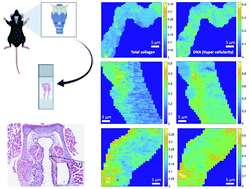Cigarette smoke-induced changes in the murine vocal folds: a Raman spectroscopic observation
Abstract
Raman spectroscopic methods are being projected as novel tools to study the early invisible molecular level changes in a label-free manner. In the present study, we have used Raman spectroscopy to explore the earliest biochemical changes in murine vocal folds in response to time-bound cigarette smoke exposure. Mice were exposed to cigarette smoke for 2 or 4-weeks through a customized smoke inhalation system. The larynx was collected and initial evaluations using standard methods of analysis such as histopathology and immunofluorescence was performed. Concurrent unstained sections were used for Raman imaging. Two common pathological features of vocal fold disorders including alterations in collagen content and epithelial hypercellularity, or hyperplasia, were observed. The mean spectra, principal component analysis, and Raman mapping also revealed differences in the collagen content and hypercellularity in the smoke exposed tissues. The differences in 2-week exposed tissues were found to be more prominent as compared to 4-week. This was attributed to adaptive responses and the already reported biphasic effects, which suggest that collagen synthesis is significantly reduced at higher cigarette smoke concentrations. Overall findings of the study are supportive of the prospective application of Raman imaging in monitoring changes due to cigarette smoke in the vocal folds.



 Please wait while we load your content...
Please wait while we load your content...